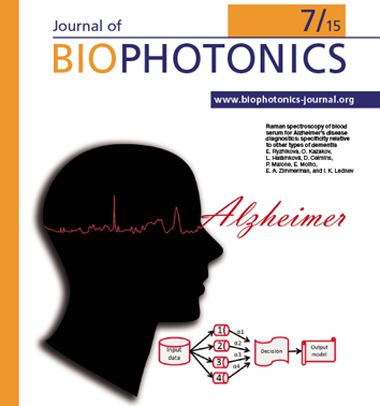Study examines new method for diagnosing Alzheimer's disease

A team of scientists at the University at Albany and Albany Medical Center have developed a new method for noninvasive diagnostics of Alzheimer's Disease (AD). Taking Raman spectra of blood samples, the research led by Igor Lednev of the University at Albany and Dr. Earl Zimmerman of Albany Medical Center, distinguished people with Alzheimer's disease from healthy controls as well as from people with other forms of dementia.
Reporting in the Journal of Biophotonics, the team applied near infrared (NIR) Raman microspectroscopy of blood serum together with advanced computer analysis for the selective identification of AD. The researchers analyzed data from 20 AD patients, 18 patients with other neurodegenerative dementias (OD) and 10 healthy control (HC) subjects. NIR Raman microspectroscopy differentiated patients with more than 95 percent sensitivity and specificity.
"We demonstrated the high discriminative power of artificial neural network (ANN) classification models, thus revealing the high potential of this developed methodology for the differential diagnosis of AD," said Lednev, a professor of chemistry at UAlbany. "Raman spectroscopic, blood-based tests may aid clinical assessments for the effective and accurate differential diagnosis of AD, decrease the labor, time and cost of diagnosis, and be useful for screening patient populations for AD development and progression."
With a worldwide estimate for patients suffering from Alzheimer's Disease—between 21 and 35 million as of 2010—the research is significant since it potentially offers a noninvasive method for differentiating AD from other forms of dementia. The team utilized a series of computer programs to determine which spectral features best separated people with AD from healthy controls or from people with other dementias The algorithms distinguished mild or moderate Alzheimer's from healthy controls and people with other dementias that opens a potential opportunity for early disease diagnostics.
While the technique does not identify individual blood components that distinguish Alzheimer's from other diseases, most of the spectral "fingerprints" occurred when photons interacted with proteins, as opposed to lipids, DNA, or other molecules that may be in the blood. "We can conclude that the composition of these blood samples differs in protein makeup," said Lednev, who is also part of UAlbany's RNA Institute.

More information: "Raman spectroscopy of blood serum for Alzheimer's disease diagnostics: Specificity relative to other types of dementia." J. Biophoton., 8: n/a. doi: 10.1002/jbio.201570070
Provided by University at Albany
















